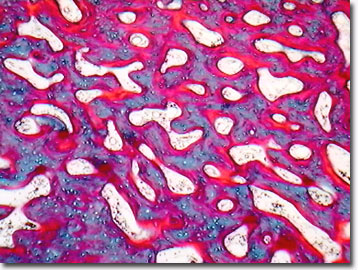Brightfield Digital Image Gallery
Developing Long Bone
Long bones are lengthy, cylindrical, hollow in the center, and are characterized by a joint at each end. They are designed to provide structural support, and various muscles attach to these bones to allow movement of the arms and legs. Nerves, veins, and arteries lie along the course of long bones.

The femur, or thighbone, is the longest bone in the human body, extending from the hip socket to the knee. Extending from the shoulder to the elbow, the humerus, or arm bone, attaches to the radius and ulna (forearm). In the lower leg, the tibia and fibula bones extend from the knee down to the ankle. The tibia is the largest bone of the lower leg, and although it supports the body's weight, the smaller adjacent fibula does not provide significant support and functions primarily for muscle attachment.
Fractures of the long bones are among the most common injuries associated with a wide variety of accidents, and a bone injury can occur at any location along the length of the bone. An injury to a long bone may mean disruption of the blood supply and loss of function as well as pain and potential permanent damage. Traction is the common treatment for a broken femur, which places tension on the broken leg, utilizing a weight, until the broken bone is aligned and healed. Other treatments include external casts and internal metal rods and pins.
Contributing Authors
Cynthia D. Kelly, Thomas J. Fellers and Michael W. Davidson - National High Magnetic Field Laboratory, 1800 East Paul Dirac Dr., The Florida State University, Tallahassee, Florida, 32310.
BACK TO THE BRIGHTFIELD IMAGE GALLERY
BACK TO THE DIGITAL IMAGE GALLERIES
Questions or comments? Send us an email.
© 1995-2025 by Michael W. Davidson and The Florida State University. All Rights Reserved. No images, graphics, software, scripts, or applets may be reproduced or used in any manner without permission from the copyright holders. Use of this website means you agree to all of the Legal Terms and Conditions set forth by the owners.
This website is maintained by our
Graphics & Web Programming Team
in collaboration with Optical Microscopy at the
National High Magnetic Field Laboratory.
Last Modification Friday, Nov 13, 2015 at 01:19 PM
Access Count Since September 17, 2002: 13512
Visit the website of our partner in introductory microscopy education:
|
|
